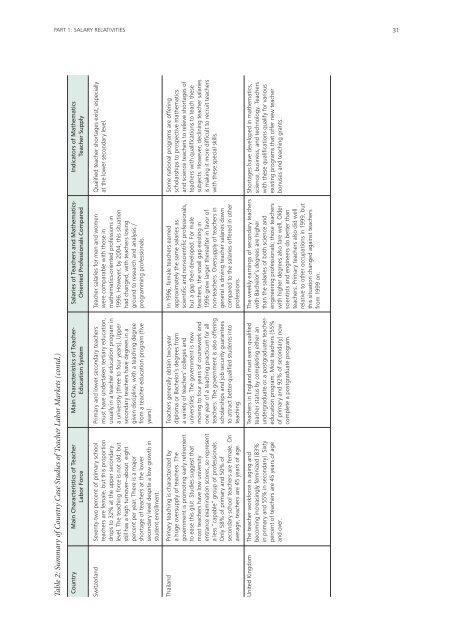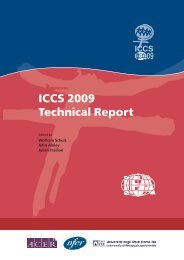Teacher Education and Development Study in Mathematics - IEA
Teacher Education and Development Study in Mathematics - IEA
Teacher Education and Development Study in Mathematics - IEA
You also want an ePaper? Increase the reach of your titles
YUMPU automatically turns print PDFs into web optimized ePapers that Google loves.
PART 1: SALARY RELATIVITIES<br />
31<br />
Table 2: Summary of Country Case Studies of <strong>Teacher</strong> Labor Markets (contd.)<br />
Country Ma<strong>in</strong> Characteristics of <strong>Teacher</strong> Ma<strong>in</strong> Characteristics of <strong>Teacher</strong>- Salaries of <strong>Teacher</strong>s <strong>and</strong> <strong>Mathematics</strong>- Indicators of <strong>Mathematics</strong><br />
Labor Force <strong>Education</strong> System Oriented Professionals Compared <strong>Teacher</strong> Supply<br />
Switzerl<strong>and</strong><br />
Seventy-two percent of primary school<br />
teachers are female, but this proportion<br />
drops to 32% at the upper secondary<br />
level. The teach<strong>in</strong>g force is not old, but<br />
still has a high turnover—about eight<br />
percent per year. There is a major<br />
shortage of teachers at the lower<br />
secondary level despite a low growth <strong>in</strong><br />
student enrollment.<br />
Primary <strong>and</strong> lower secondary teachers<br />
must have undertaken tertiary education,<br />
usually <strong>in</strong> a teacher education program <strong>in</strong><br />
a university (three to four years). Upper<br />
secondary teachers have degrees <strong>in</strong> a<br />
given discipl<strong>in</strong>e, with a teach<strong>in</strong>g degree<br />
from a teacher education program (five<br />
years).<br />
<strong>Teacher</strong> salaries for men <strong>and</strong> women<br />
were comparable with those <strong>in</strong><br />
mathematics-oriented professions <strong>in</strong><br />
1996. However, by 2004, this situation<br />
had changed, with teachers los<strong>in</strong>g<br />
ground to research <strong>and</strong> analysis /<br />
programm<strong>in</strong>g professionals.<br />
Qualified teacher shortages exist, especially<br />
at the lower secondary level.<br />
Thail<strong>and</strong> Primary teach<strong>in</strong>g is characterized by<br />
a huge oversupply of teachers. The<br />
government is promot<strong>in</strong>g early retirement<br />
to ease this glut. Studies suggest that<br />
most teachers have low university<br />
entrance exam<strong>in</strong>ation scores, so represent<br />
a less “capable” group of professionals.<br />
Only 58% of primary <strong>and</strong> 50% of<br />
secondary school teachers are female. On<br />
average, teachers are 45 years of age.<br />
<strong>Teacher</strong>s generally obta<strong>in</strong> two-year<br />
diploma or Bachelor’s degrees from<br />
a variety of teachers’ colleges <strong>and</strong><br />
universities. The government is now<br />
mov<strong>in</strong>g to four years of coursework <strong>and</strong><br />
one year of a teach<strong>in</strong>g practicum for all<br />
teachers. The government is also offer<strong>in</strong>g<br />
scholarships <strong>and</strong> job security guarantees<br />
to attract better-qualified students <strong>in</strong>to<br />
teach<strong>in</strong>g.<br />
In 1996, female teachers earned<br />
approximately the same salaries as<br />
scientific <strong>and</strong> non-scientific professionals,<br />
but a gap then developed. For male<br />
teachers, the small gap exist<strong>in</strong>g <strong>in</strong><br />
1996 grew larger thereafter <strong>in</strong> favor of<br />
non-teachers. Oversupply of teachers <strong>in</strong><br />
general is driv<strong>in</strong>g teacher salaries down<br />
compared to the salaries offered <strong>in</strong> other<br />
professions.<br />
Some national programs are offer<strong>in</strong>g<br />
scholarships to prospective mathematics<br />
<strong>and</strong> science teachers to relieve shortages of<br />
teachers with qualifications to teach these<br />
subjects. However, decl<strong>in</strong><strong>in</strong>g teacher salaries<br />
is mak<strong>in</strong>g it more difficult to recruit teachers<br />
with these special skills.<br />
United K<strong>in</strong>gdom<br />
The teacher workforce is ag<strong>in</strong>g <strong>and</strong><br />
becom<strong>in</strong>g <strong>in</strong>creas<strong>in</strong>gly fem<strong>in</strong>ized (83%<br />
<strong>in</strong> primary <strong>and</strong> 55% <strong>in</strong> secondary). Sixty<br />
percent of teachers are 45 years of age<br />
<strong>and</strong> over.<br />
<strong>Teacher</strong>s <strong>in</strong> Engl<strong>and</strong> must earn qualified<br />
teacher status by complet<strong>in</strong>g either an<br />
undergraduate or a postgraduate teachereducation<br />
program. Most teachers (55%<br />
of primary <strong>and</strong> 92% of secondary) now<br />
complete a postgraduate program.<br />
The weekly earn<strong>in</strong>gs of secondary teachers<br />
with Bachelor’s degrees are higher<br />
than the salaries of both science <strong>and</strong><br />
eng<strong>in</strong>eer<strong>in</strong>g professionals; those teachers<br />
with higher degrees also fare well. Older<br />
scientists <strong>and</strong> eng<strong>in</strong>eers do better than<br />
teachers. Primary teachers also did well<br />
relative to other occupations <strong>in</strong> 1999, but<br />
this situation changed aga<strong>in</strong>st teachers<br />
from 1999 on.<br />
Shortages have developed <strong>in</strong> mathematics,<br />
science, bus<strong>in</strong>ess, <strong>and</strong> technology. <strong>Teacher</strong>s<br />
with these qualifications qualify for various<br />
exist<strong>in</strong>g programs that offer new teacher<br />
bonuses <strong>and</strong> teach<strong>in</strong>g grants.

















